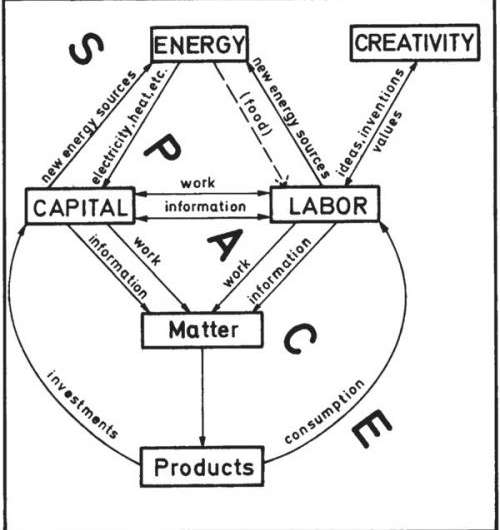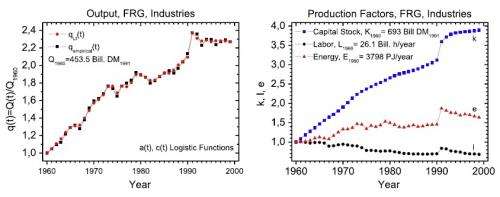December 31, 2014 feature
Thermodynamic analysis reveals large overlooked role of oil and other energy sources in the economy

(Phys.org)—The laws of thermodynamics are best known for dealing with energy in the context of physics, but a new study suggests the same concepts could help improve economic growth models by accounting for energy in the economic sphere.
In neoclassical growth models, there are two main contributing factors to economic growth: labor and capital. However, these models are far from perfect, accounting for less than half of actual economic growth. The rest of the growth is accounted for by the Solow residual, which is thought to be attributed to the difficult-to-quantify factor of "technological progress."
Although neoclassical growth models help economists understand economic growth, the fact that they leave so much economic growth unexplained is a little unsettling. Even Robert A. Solow, the founder of neoclassical growth theory, stated that the neoclassical model "is a theory of growth that leaves the main factor in economic growth unexplained."
Energy, a powerful factor of production
In a new study published in the New Journal of Physics, Professor Reiner Kümmel at the University of Würzburg and Dr. Dietmar Lindenberger at the University of Cologne argue that the missing ingredient represented by the Solow residual consists primarily of energy. They show that, for thermodynamic reasons, energy should be taken into account as a third production factor, on an equal footing with the traditional factors capital and labor.
(By definition, labor represents the number of work hours per year. Capital refers to the capital stock that is listed in the national accounts, which consists of all energy-converting devices, information processors, and the buildings and installations necessary for their protection and operation. Energy includes fossil and nuclear fuels, as well as alternative energy sources.)
The new proposal lies in stark contrast to neoclassical growth models, in which the production factors have very different economic weights, representing their productive powers. In neoclassical growth models, these economic weights or "output elasticities" are set equal to each production factor's cost share: Labor's cost share is 70%, capital's is 25%, and energy's is just 5%.
In their analysis, the researchers found that, unlike in neoclassical models, the economic weights of energy and labor are not equal to their cost shares. While the economic weight of energy is much larger than its cost share, that of labor is much smaller. This means that energy has a much higher productive power than labor, which is mainly because energy is relatively cheap while labor is expensive.

Real-world implications
To test their model on reality, Kümmel and Lindenberger applied it to reproduce the economic growth of Germany, Japan, and the US from the 1960s to 2000, paying particular attention to the two oil crises. In neoclassical models, reductions of energy inputs by 7%, as observed during the first energy crisis in 1973-1975, should have caused total economic output reductions of only 0.35%, whereas observed reductions were up to an order of magnitude larger. By using the larger weight of energy, the new model can explain a much larger portion of the total output reductions during this time.
If correct, their findings have major implications. First, the new model doesn't require the Solow residual at all; this residual disappears from the graphs that show the empirical and the theoretical growth curves. Energy, along with the addition of a smaller "human creativity" factor, accounts for all of the growth that neoclassical models attribute to technological progress.
Second, and somewhat unsettling, is the impact that the findings may have in the real world. In 2012, the International Monetary Fund stated in its World Economic Outlook that "…if the contribution of oil to output proved to be much larger than its cost share, the effects could be dramatic, suggesting a need for urgent policy action."
According to the authors' analysis, the high productive power of cheap energy and the low productive power of expensive labor has implications that we can easily observe. On one hand, the average citizens of highly industrialized countries enjoy a material wealth that is unprecedented in history. On the other hand, cheap, powerful energy-capital combinations are increasingly replacing expensive, weak labor in the course of increasing automation. This combination kills jobs for the less skilled part of the labor force. It is also why far fewer people work in agriculture and manufacturing today than in the past, and more people work in the service sector—although even here, computers and software are replacing labor or causing job outsourcing to low-wage countries. This well-known trend can be understood by the new model's message that energy is cheaper and more powerful than labor.
Where is equilibrium?
At the heart of Kümmel and Lindenberger's model is the concept of thermodynamic equilibrium. As the researchers explain, economies are supposed to operate in an equilibrium where an objective, such as profit or overall welfare, has a maximum. To maximize these objectives, neoclassical economics assumes that there are no constraints on the combinations of capital, labor, and energy. With no constraints, economic equilibrium is characterized by the equality of output elasticities and cost shares, which is one of the assumptions of neoclassical growth models as described above.
In their new model, Kümmel and Lindenberger apply the same optimization principles, but also take into account technological constraints on production factor combinations. In reality, a production system cannot operate at more than full capacity, and its degree of automation at a given time is limited by the quantities of energy-conversion devices and information processors that the system can accommodate at that time. Further, legal and social obligations may place "soft" constraints on the production factors, particularly labor.
In the new model, these technological constraints on the production factors prevent modern industrial economies from reaching the neoclassical equilibrium where the output elasticities of capital, labor and energy are equal to these factors´ cost shares. Rather, the equilibrium of real-life economies, which are limited by technological constraints, is far from the neoclassical equilibrium.
While the model provides a new perspective of economic growth, the ultimate question still remains: what kinds of strategies will stimulate economic growth and reduce unemployment and emissions? Whatever the answer, the results here suggest that it must account for the pivotal role of energy in economic production.
"Within the present legal framework of the market, one needs economic growth to ban the specter of unemployment," the researchers explain. "Energy-driven economic growth, in turn, may lead to increasing environmental perturbations, because, according to the first and second law of thermodynamics, nothing happens in the world without energy conversion and entropy production. And entropy production is associated with the emissions of heat and particles, notably carbon dioxide as long the world uses fossil fuels at the present rate."
Kümmel is also the author of a book on the subject called The Second Law of Economics: Energy, Entropy, and the Origins of Wealth.
More information: Reiner Kümmel and Dietmar Lindenberger. "How energy conversion drives economic growth far from the equilibrium of neoclassical economics." New Journal of Physics. DOI: 10.1088/1367-2630/16/12/125008
Journal information: New Journal of Physics
© 2014 Phys.org

















